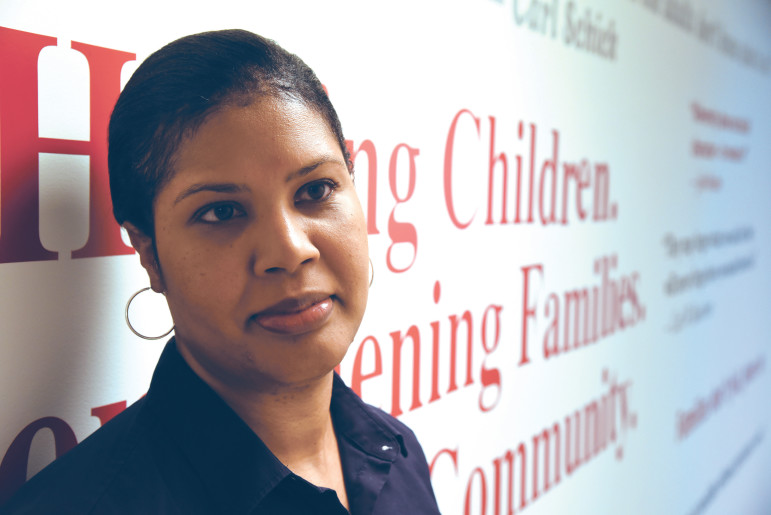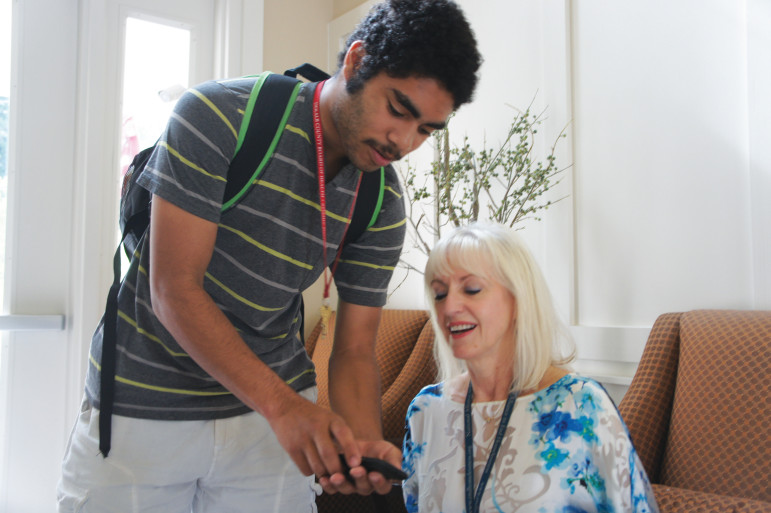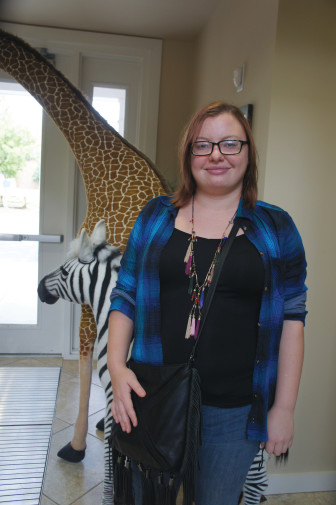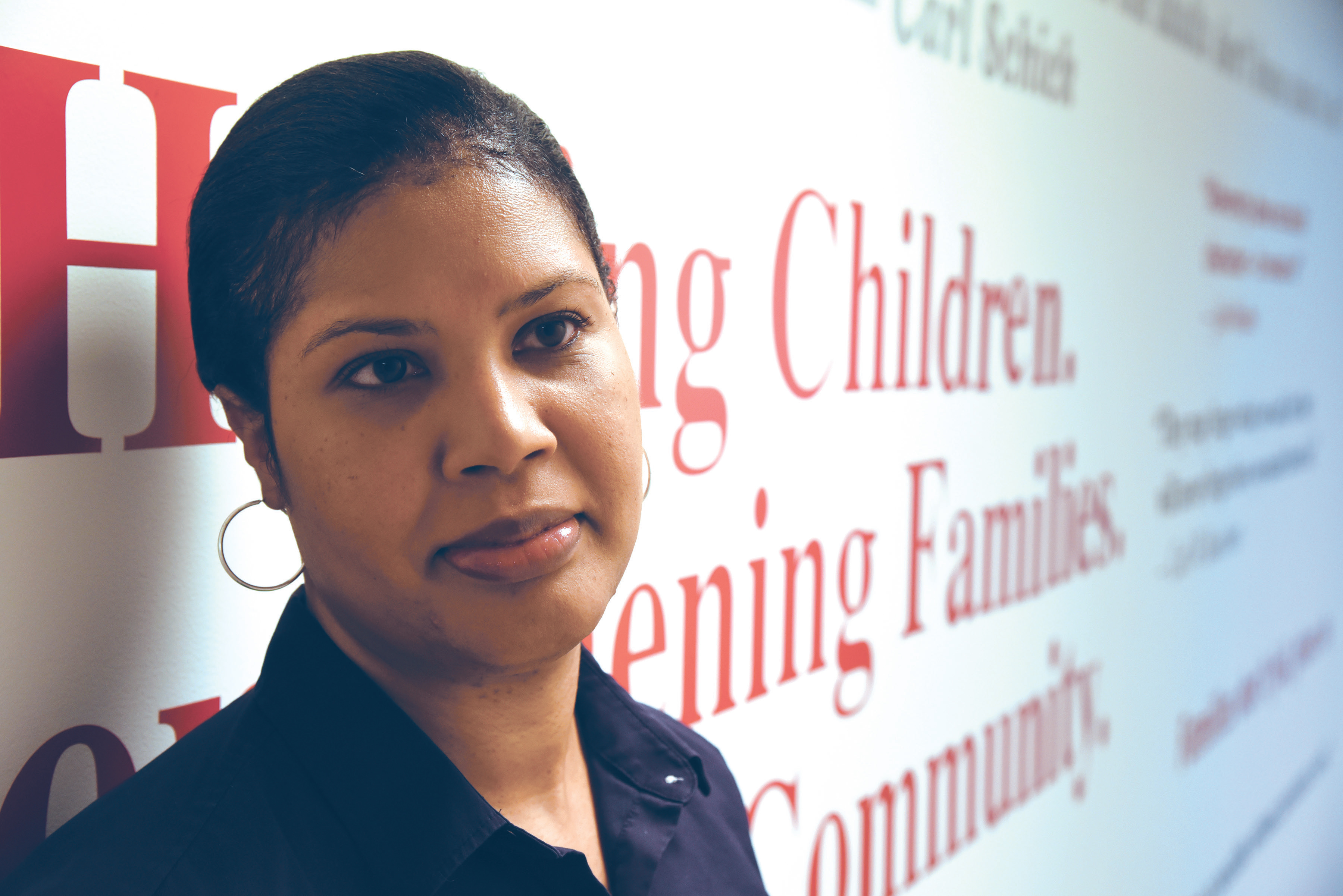
ROGER NEWTON
Melissa Robinson-Graves serves as director of the CHRIS Training Institute, which brings a trauma-informed approach to service and training for youth-service professionals. Kids “act the way they do for a reason,” she says. Withdrawal or aggression, for example, can be the result of traumatic stress.
Trauma-informed work requires integration throughout entire organization
Vika, 20, sits in the office of CHRIS Kids in Atlanta laughing and joking. She’s recently moved into the organization’s transitional living center for young adults, a 41-unit brick apartment complex known as Summit Trail.
She’s a lively, auburn-haired young woman, but when she speaks about the past, she becomes serious.
Born in Russia, she was abandoned on a train at age 4. Police took her to an orphanage, where it became clear that she had developmental delays in speaking and interacting with others.
At age 5, she was adopted by an American woman and taken to California. Later they moved to Georgia.
Vika described herself as lonely and suicidal during her teen years. She once tried to jump out a window.
“My mom stopped me,” she said.
But she also fought with her mother. The fighting got so bad, her mother took her to juvenile court, where a judge placed her in a group home run by CHRIS Kids. The 34-year-old organization operates eight group homes and a transitional living center for youth who have been in the child welfare system — among other services.
CHRIS Kids uses a trauma-informed approach with young people and their families — in its counseling center and in its training center for professionals.
Today, Vika’s life has settled down.
She recently celebrated her birthday with her mother and aunt in a restaurant. “My mom and I are good now,” she said.
Working with trauma
“Trauma-informed” means care is based on a knowledge of trauma and how it affects people. With the right support and assistance, people can recover from traumatic experiences.

STELL SIMONTON
Scott, 19, came to CHRIS Kids after a traumatic childhood and found choice and freedom, which CHRIS Kids CEO Kathy Colbenson (at right) calls “an antidote to powerlessness.”
But most people don’t get these supports, according to the U.S. Substance Abuse and Mental Health Services Administration (SAMHSA) in its 2014 report “SAMHSA’s Concept of Trauma and Guidance for a Trauma-Informed Approach.”
If trauma isn’t addressed, the risk of mental health disorders, substance abuse and even physical illness is much greater, according to the report.
Kids are shaped by their past experiences, said Kathy Colbenson, chief executive officer of CHRIS Kids. Behaviors that seem outof- the-blue are not disconnected, she said. When a child acts in a way that is strange, difficult or problematic for adults — that should be a clue that something is not right, she said.
“I don’t think a lot of people connect the dots,” agrees Melissa Robinson-Graves, director of the CHRIS Training Institute.
But kids “act the way they do for a reason,” she said. Withdrawal or aggression, for example, can be the result of traumatic stress.
Robinson-Graves said organizations that work with kids may not make the connection between the past and present. Staff members “get caught up in the day-to-day responsibilities of their job and simply react,” she said.
“If you are a staff member at an afterschool program and there is a child acting out — or you work in a group home and a teenager is cursing and yelling — the staff has to think in the moment,” she said. It takes training to respond appropriately instead of simply reacting.
A trauma-informed response doesn’t necessarily mean a staff member is automatically thinking: “I wonder if his behavior is connected to past trauma.” What it does mean is being calm, curious and developing a plan of action, Robinson-Graves explained.
It’s important for any organization working with kids to be trauma-informed, Colbenson said.
“Then you can offer some help rather than labeling a child as bad and disruptive,” she said.
It’s a very powerful step to replace judgment of problematic behavior with curiosity about it, she said. This shift creates compassion and makes it more likely that a young person can be helped.
Trauma does not necessarily stem from one terrible event in the past, Robinson- Graves explained. It can be multiple experiences over time. Trauma can also be ongoing in the present, as when kids are locked up away from others in juvenile detention, she said.
In one study of 12- to 17-year-olds, 8 percent had been sexually assaulted, 17 percent physically assaulted and 39 percent had witnessed violence, according to the National Child Traumatic Stress Network. Another study of 536 kids in inner-city elementary and middle schools found that 30 percent had seen a stabbing, and 26 percent had witnessed a shooting, according to the network.
More than treatment
A trauma-informed approach within an organization is not simply about using certain treatments, according to SAMHSA.
It requires recognizing the signs and the impact of trauma and understanding paths to recovery. It also requires integrating this knowledge in all procedures and practices, according to the SAMHSA report.
[Related: New Toolkit Issued to Help Providers Measure Trauma With ACES Survey]
For child welfare organizations, using a trauma-informed approach may require a paradigm shift, according to the U.S. Child Welfare Information Gateway issue brief, “Developing a Trauma-Informed Child Welfare System.”
Behaviors once seen as stemming from mental illness may need to be reinterpreted: Behaviors of young people labeled “bad” may need to be re-evaluated as “the potentially reversible consequences of trauma,” the report indicates.
Creating an environment that is physically and emotionally safe is crucial, according to the SAMHSA report.
A safe place to heal
The name CHRIS Kids is an acronym that comes from the organization’s values: creativity, honor, respect, integrity and safety. It serves about 4,500 children and adults each year in its varied programs.
The 34-year-old organization has always operated with an awareness of trauma, Colbenson said, but in 2007 it began heavily investing in training staff to work with trauma. She sees the training as a “huge key to recovery” of clients.

Vika shows visitors around CHRIS Kids’ welcoming office, Counseling Center and Clubhouse, all part of an organization that takes a trauma-informed approach to supporting young people and training other adults who work with youth.
In 2014, CHRIS Kids adopted a specific model for working with trauma known as Attachment, Self-Regulation and Competency (ARC) framework. It was developed at the Trauma Center at Justice Research Institute in Massachusetts and is recognized as a promising practice by the National Child Traumatic Stress Network and SAMHSA.
The bottom line for trauma-informed work is emotional and psychological safety, Robinson-Graves said.
Safety is communicated through the way people interact, but the physical surroundings also contribute.
“The environment is soothing,” Colbenson said. “We have been very intentional” in creating it.
Rocking chairs line the front porch of CHRIS Kids’ counseling center, and therapists and clients are free to sit there as they work together.
At CHRIS Kids, Colbenson said, young people learn to identify their feelings. They are taught new ways of expressing themselves. Staff members also model positive ways of speaking and acting, which reinforces the message that the environment is safe.
Kids also learn self-soothing techniques to cope with intense feeling — techniques as simple as deep breathing or stepping out of a room and running cold water over their wrist.
Kids receive the message that they are not bad. Instead, something bad happened to them.
Trauma-informed work also focuses on giving kids choice, Colbenson said.
“We give a lot of little choices,” she said. It sends a message to young people that they matter, she said.
Professionals at CHRIS Kids act more as coaches and less as authorities. “Our attitude is: ‘How can we help you?’” Colbenson said.
Robinson-Graves said another important ingredient is a positive youth development approach, which focuses on the competency of the kids it serves.
“Instead of asking what’s wrong with you, we ask what’s happened to you?” she said.
The work needs to be strengths-based, she said.
Knowing what you’re doing
CHRIS Kids uses specific evidence-based treatments for kids in its counseling center and residential services, including traumafocused cognitive behavioral therapy, behavioral therapy, cognitive-behavioral therapy and play therapy — all undergirded by the trauma treatment, Colbenson said.
“Everything is trauma-informed, and we work together to create an individual treatment plan,” she said.
Not all youth-serving organizations that say they provide trauma-informed care really do, said Cindy Simpson, CHRIS Kids chief operating officer.
“The true test is: Do you have staff trained in evidence-based practices,” Simpson said. And the organization should be able to explain exactly why it is using a particular practice with a particular young person.
Different kids need different approaches. “It’s not one-size-fits-all,” she said.
At CHRIS Kids, it’s not just the clinical group who understands trauma. The organization trains paraprofessionals and other staff to interact with young people in a way that doesn’t feed into their negative behaviors, Simpson said.
The staff avoid issuing orders. With a kid who’s agitated, for example, they may pose questions. “Do you need something?” they ask.
“It’s a big change for a lot of people,” Simpson said.
A trauma-informed environment is as important as trauma-informed therapy, Colbenson said. Kids need that environment in order to practice new ways of being.
Seeking freedom
Scott is a lean 19-year-old with an intense gaze. He arrived at the transitional living center at the end of the summer. He lives in a two-bedroom apartment with a CHRIS Kids roommate and works at Wendy’s.
When he was young, his parents neglected and starved him and his siblings. Such experiences leave kids feeling deeply powerless.
Scott was arrested for the first time at age 12, for theft, and was in and out of juvenile detention for the next three years. Once he stole a Dodge Chrysler 300. Another time he used a knife to attack someone.
He spent nearly a year in a residential treatment facility for youth with emotional and psychological challenges.
“I’ve been diagnosed with everything in the book,” he said.
At the transitional living center, he’s learning, he said. “I have to respect my roommate,” he said.
One aspect of the trauma-informed care at CHRIS Kids is to offer choices — even small ones.
“Choice is an antidote to powerlessness,” Colbenson said. It helps build kids back up and helps them heal. They gain confidence that they can make decisions about their life — and they begin to do it.
“The good news is … you don’t have to be defined by the past,” Colbenson said.
This approach has been important to Scott.
“I love it here,” he exclaimed. “I have freedom.”
More related articles:
Minnesota High School Screens Students for ACEs to Develop Trauma-informed Education
We Know How to Help Foster Kids Despite Past Trauma
A Trauma-informed School Wasn’t Part of My Plan, But Now It’s My Life’s Work






























